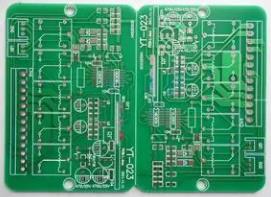As an important component of the modern electronic information industry, the printed circuit board has the following obvious characteristics:
(1) Integrated circuits are inseparable from printed boards. Integrated circuit (IC) technology reflects a country's industrial modernization level and guides the development of the electronic information industry. The electrical interconnection and assembly of ICs are inseparable from printed circuit boards. The further integration and miniaturization of electronic equipment, especially the gradual development of large-scale and very large-scale integrated circuits, make the technology and manufacturing of printed boards must also be adapted to it. At present, IC technology and printed circuit technology are moving closer to each other, infiltrating each other, and cooperating more closely. Therefore, printed boards will continue to develop in the 21st century.
(2) High-tech products are indispensable for printed boards, which play a role in connecting various electronic components and electrical interconnections in electronic equipment products. In the military, many printed circuit boards are used in artificial satellites, intercontinental missiles, rocket launches, and aerospace. For example, the American Apollo moon landing spacecraft uses 42-layer printed circuit boards. Printed boards are the basic components of flat color TVs, digital cameras, fully automatic washing machines, and video phones in modern homes. When you turn on the computer and the communication machine, you will see a piece of sophisticated multi-layer printed circuit board. Tens of thousands of program-controlled digital switches used in each city require dozens of varieties of double-sided boards, multilayer boards, motherboards, and large backplanes. Notebook computers, mobile phones, digital cameras, camcorders, automobiles, satellites, navigators and other trend-leading high-tech products have used a large number of high-density interconnections, high reliability, high-precision buried blind holes, thin rigid and flexible Layer printed board. Similarly, many small holes (φ0.1mm~φ0.3mmam) and thin wires (O.075~O.) are indispensable in modern science and technology medical equipment, petroleum exploration, satellite communications and other industries, such as B-ultrasound, electrocardiogram testing, automobile instrumentation, etc. 13mm), double-sided SMT (surface mount technology), BGA (ball grid array package), QFP (quad flat package) double-sided, multilayer printed board. Over the years, all kinds of high-tech products that have emerged are closely related to printed boards and put forward various new requirements for printed boards.

(3) Modern science and management are embodied in a printed board company. A foreign entrepreneur said that if you can manage a multi-layer board factory, you can manage any other factory. This sentence shows that a large-scale multilayer board factory is complicated and difficult to manage. The printed board industry involves more than five.
1. Multiple subjects. Printed board production includes polymer chemistry, optics, precision processing, electronic technology, automatic control, computer technology and other disciplines.
2. Various technologies. Including computer-aided design and manufacturing (CAD/CAM), CNC drilling, light imaging pattern transfer, hole metallization, pattern plating, acid and alkaline etching, plug nickel/gold plating, hot air leveling, liquid light imaging solder mask, Many complex process technologies such as multi-layer lamination and interlayer positioning, on-off testing, etc.
3. Multiple processes. There are thirty to forty processes in the process of making buried-blind-via multilayer boards. Many processes include ten or twenty sub-processes. If any one process goes wrong, all previous efforts will be discarded and the product will be scrapped.
4. A variety of equipment. Each process requires many high-precision computer-controlled automation equipment to complete, such as laser light plotters, CNC drilling/milling machines, vacuum laminators, automatic electroplating lines, automatic optical inspection systems, multi-layer positioning systems, various All kinds of special test equipment, etc., each equipment costs hundreds of thousands of dollars.
There are also many auxiliary equipment. A PCB factory needs compressed air, central air conditioning (constant temperature, humidity and dust-free part of the process), pure water, sewage treatment station, stabilized power supply, fire protection and other auxiliary equipment systems. The combined investment of these facilities accounted for about 30% of the total investment.
5. A variety of materials. A PCB factory needs to use hundreds of materials and auxiliary materials, such as dry film, copper clad laminates, prepregs (adhesive sheets), various chemicals, chemical additives, drills, milling cutters, special tapes, solder masks, etc.
As we all know, the printed board industry belongs to a typical market economy. Each board must be produced according to the customer's design. If there is no customer order, the factory will have to stop working. To sum up, the printed board industry is a technology-intensive and capital-intensive industry; of course, it is also a highly polluting industry (many chemical materials are used in the production process, and sewage treatment is complicated). It must be produced on a large scale and technically advanced. Only when equipment is upgraded and the market competes internationally can we survive and develop. Therefore, it is unthinkable for a printed board factory without modern management. Many modern sciences and management have also been fully reflected in the printed board enterprises.
(4) my country's reform and opening up promoted the rapid development of the printed board industry. In 1957, my country's first printed board was born. After nearly 50 springs and autumns, especially in the more than 20 years after the reform and opening up, my country's PCB industry has achieved rapid development.